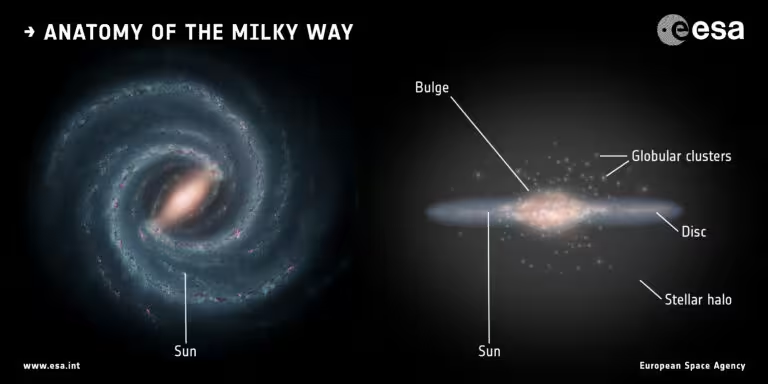6 Minutes
The Hidden Influence of Dark Matter in Galactic Evolution
Galaxies are intricate cosmic structures, far more complex than their visible stars suggest. At the heart of this complexity lies dark matter—a mysterious, invisible substance that exerts a crucial influence on the birth and evolution of galaxies. Long before the first stars illuminated the universe, dark matter began to cluster, using its gravitational pull to gather ordinary matter. This process formed the unseen framework—often referred to as the 'dark matter halo'—that provided the foundation for galaxies like our own Milky Way.
Modern astronomical research has established that nearly every galaxy remains enveloped in these massive halos of dark matter. These halos stretch well beyond a galaxy’s visible edge, acting as cosmic anchors that prevent stars from escaping into intergalactic space, despite their rapid motion. The ongoing interplay between dark matter and ordinary matter shapes galactic dynamics and evolution.
Until recently, most scientific inquiry focused on how dark matter influences ordinary matter (baryonic matter). However, new studies have begun to investigate the reverse: can ordinary matter, especially the stars and gas within a galaxy’s spiral arms, in turn affect dark matter itself?
Probing the Mutual Dance: Spiral Arms and Dark Matter
Spiral galaxies such as the Milky Way are instantly recognizable by their spectacular, star-filled arms. Although these spirals appear as graceful waves of stars and gas, astronomers view them as pressure waves or 'traffic jams'—regions where matter becomes temporarily crowded as it orbits the galactic core.
Recent cutting-edge simulations suggest an extraordinary phenomenon: dark matter spirals, ghostly counterparts to the visible spiral arms, may be lurking in the halos above and below the galactic plane. Researchers detected these subtle features by examining the gravitational wake generated by the movements of visible spiral arms within simulated galaxies. Artist renderings visualize these hypothetical dark matter spirals enveloping the familiar galactic disk, indicated by green outlines in edge-on and face-on views of the Milky Way.
The theoretical groundwork for this discovery traces back to 1943, when Nobel laureate Subrahmanyan Chandrasekhar described 'dynamical friction.' In astrophysical terms, this process occurs when a massive object moves through a field of lighter particles, stirring up a trailing gravitational wake that exerts a drag force—somewhat akin to a boat producing ripples as it glides through water. Over time, this effect causes orbiting galaxies and stellar objects to slow down, spiraling inward rather than speeding up, a phenomenon observed with the Milky Way’s own satellite dwarf galaxies.
Marcel Bernet, a doctoral researcher at the University of Barcelona, was inspired by these theoretical insights to ask: could the bright, rotating arms of a spiral galaxy likewise induce similar gravitational wakes within the surrounding dark matter halo?

Simulations Uncover the Gravitational Shadows of Dark Matter
Methodology and Scientific Approach
To explore this question, Bernet and his team turned to high-resolution galaxy simulations, which are powerful tools for tracing cosmic evolution over billions of years. These virtual universes allow scientists to model the collective behavior of stars, gas, and dark matter across timescales far exceeding the span of a human life.
In these simulations, countless digital particles represent the different components of real galaxies. As the simulated galaxies evolved, researchers looked for subtle dark matter patterns—specifically, spiral-shaped features lagging just behind the visible arms, like shadows cast by a hidden hand.
Remarkably, the team identified these dark matter spirals across multiple independent simulations, strengthening the evidence that this phenomenon is a general property of spiral galaxies and not a feature specific to a particular code or setup. The dark matter spirals are less pronounced than their stellar counterparts, but they leave a measurable imprint in the motion of dark matter particles.
Expert Insights and Scientific Implications
While previous models underestimated the feedback ordinary matter (baryons) could have on dark matter, new evidence is reshaping this understanding. As Rutgers astrophysicist Alyson Brooks, who was not involved in Bernet’s study, points out: "For a long time, astronomers overlooked the impact of gas and stars on dark matter, which led to misconceptions about galaxy formation. Now, it appears that incorporating these interactions brings our models closer in line with observed galaxies and their mass distribution."
This intricate dance between normal and dark matter could have far-reaching consequences for our theories about how galaxies form, how their spiral arms maintain their shape, and even how dark matter is distributed within galactic disks.
Searching for Dark Matter Shadows in the Universe
Observational Prospects and Measurement Challenges
Bernet proposes that future surveys might be able to detect these dark spirals by carefully measuring the density of dark matter throughout the Milky Way’s disk. "Currently, we can determine the dark matter density near our solar neighborhood with impressive precision," Bernet notes. "If we extend these measurements across the entire galactic disk, we should be able to identify spiral patterns in the dark matter distribution—provided they exist."
However, observing these elusive trails in the actual universe presents significant challenges. Dark matter does not emit, absorb, or reflect light, making it almost impossible to detect directly with traditional telescopes. Instead, astronomers rely on its gravitational influence—such as how it bends the paths of stars or distorts the orbits of gas clouds.
Despite these hurdles, the discovery opens new directions for both indirect detection methods and laboratory experiments. Theoretical predictions of denser dark matter regions near spiral arms could refine the strategies used in direct dark matter detection experiments—an elusive prize that has captivated scientists for nearly a century.
As Brooks adds, “These results are crucial because they shift our expectations about where to look for dark matter signatures in galaxies. Our understanding of dark matter density near the solar system and our planning for dark matter experiments may both be affected by these findings.”
Conclusion
The identification of spiral-shaped wakes of dark matter trailing the luminous arms of galaxies marks a significant leap in our understanding of galactic evolution and the role of dark matter. These discoveries highlight that dark matter is not merely an invisible, static scaffold, but an active participant finely tuned to the gravitational ballet of stars, gas, and cosmic history. Future research, both observational and experimental, may soon unlock more secrets about the subtle fingerprints of dark matter, edging us ever closer to one of astrophysics' ultimate goals: direct detection and comprehensive understanding of the universe’s hidden mass.
Source: arstechnica



Comments